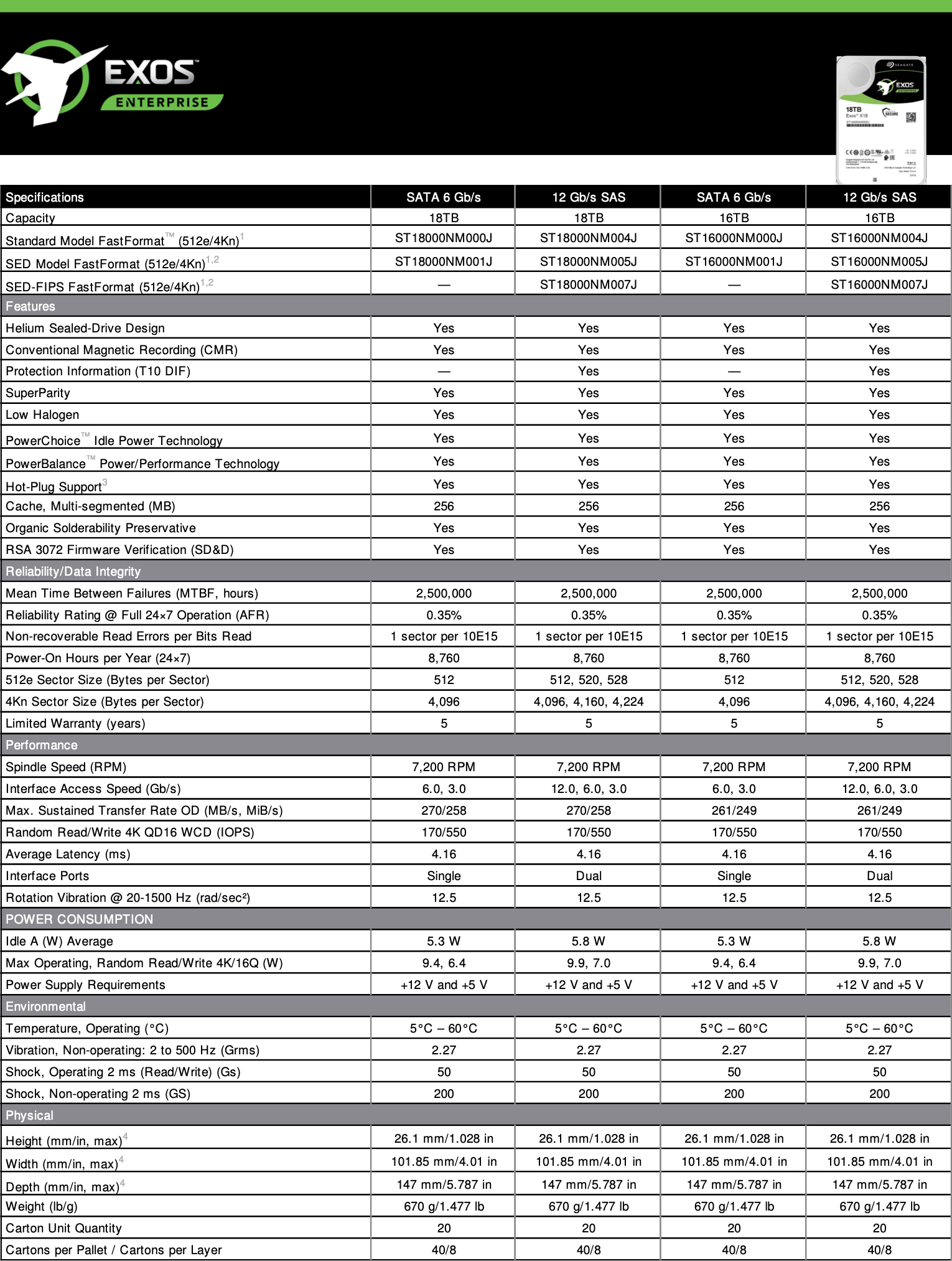Seagate Reveals Its Exos X18 HDDs: 18 TB for Exascalers and Datacenters
The last enterprise-grade high-capacity hard drive before HAMR?
Seagate has formally announced its Exos X18 family of datacenter-grade hard drives that it has been shipping to select clients for a while now. The HDDs are designed for enterprise and hyperscale datacenters that demand maximum storage density available today, but these products may also be used for high-end NAS and even desktops.
The Exos X18: Improving Capacity and Performance
The 3.5-inch Seagate Exos X18 family includes 16 TB and 18 TB hard drives that are based on the company’s fifth-generation helium-filled HDD platform. This platform relies on nine perpendicular magnetic recording (PMR) platters (featuring a capacity of up to 2 TB) as well as 18 heads that use two-dimensional magnetic recording (TDMR) technology to prevent adjacent track interference and reliably read data at a high track pitch density. The drives feature a 7200 RPM spindle speed as well as a multi-segmented 256 MB cache.
The Exos X18 18 TB model uses 2 TB platters with an areal density of 1022 Gbit/inch2, which enables the HDD to increase its maximum sustained transfer rate to 270 MB/s (up from 261 MB/s in case of 16 TB drives). Meanwhile, all Exos X18 SKUs are rated for up to 170/550 random read/write IOPS (4K, QD16), up from 170/440 random read/write IOPS in case of the previous-generation Exos X16 HDDs.
Like all enterprise-grade hard drives, Seagate’s Exos X18 feature various design enhancements to improve reliability and ensure predictable performance in highly-vibrating environments, including a top and bottom attached motor, RV sensors, and other means to reduce turbulence. As far as endurance is concerned, all Exos HDDs are rated for up to 550TB/year workload over a five-year period.
Also, in a bid to provide maximum flexibility to its large clients, Seagate’s Exos X18 HDDs support the company’s PowerBalance technology that allows operators of datacenters to balance power consumption and IOPS (input/output operations per second) performance as well as PowerChoice technology that enables to manage power consumption during idle time.
To meet requirements of different customers, Seagate will offer its Exos X18 HDDs with a SATA 6 Gbps or a dual-port SAS 12 Gbps interface. The SATA versions consume from 5.3W in active idle mode to 6.4W/9.4W during write/read operations, whereas the SAS models are rated for 5.8W in active idle mode as well as for 7.0W/9.9W during write/read operations.
4.3 PB per Standard Rack
Tremendous amounts of data are generated every day, so operators of datacenters strive to extend their storage densities by using higher-capacity HDDs. As a result, the new Exos X18 18 TB drive — which allows to store 4.3 PB per standard rack or 18 PB if high-density 4U storage servers with ~100 drives per box are used — will receive a warm welcome from Seagate’s clients. In fact, the company expects these HDDs to be as successful as its Exos X16 products that are now used by numerous cloud and hyperscale datacenter operators.
Get Tom's Hardware's best news and in-depth reviews, straight to your inbox.
“Our fiscal year performance underscores the success of our 16 TB nearline drives and launch of our common scalable platform,” said Dave Mosley, CEO of Seagate, during the most recent earnings call. “These drives are now used by the world's leading cloud and hyperscale names. We target achieving the same success with our 18 TB drives. This common platform approach helps to simplify the qualification process for our customers, while allowing Seagate to improve operational efficiency.”
The Last Big HDDs Before HAMR?
Seagate is on-track to ship its first 20 TB hard drives based on its heat-assisted magnetic recording (HAMR) technology this year. Therefore, the Exos X18 could be the last family of Seagate’s high-capacity HDDs that do not use any kind of energy-assisted magnetic recording technology. Meanwhile, HAMR opens doors to areal densities well beyond 1000 Gbit/inch2 and promises to increase capacity of a 3.5-inch HDD to 70 TB or 80 TB in the future.
“With our 20 TB, which we will ship by the end of the calendar year, we are going to introduce HAMR,” said Mr. Mosley at Citi 2020 Global Technology Conference Call. “Importantly, it goes into the same platform that we have been staging the same 16 TB – 18 TB platform. So that de-risks the technology transition that we have to go on.
Available Now
Seagate’s Exos X18 18 TB hard drives are now available from resellers and retailers for an MSRP of $561.75. It is noteworthy that the recommended price of Seagate’s 18 TB drives is slightly lower than prices of flagship HDDs in the recent years. Typically, such drives retail for about $700.

Anton Shilov is a contributing writer at Tom’s Hardware. Over the past couple of decades, he has covered everything from CPUs and GPUs to supercomputers and from modern process technologies and latest fab tools to high-tech industry trends.
-
nofanneeded 18TB harddisks should include onbard 256GB NVME SSD and the interface changed into U.2 instead of SATA/SAS.Reply -
neojack i wonder how much time it takes to rebuild an array when one of those monsters failsReply
i mean, even with a raid 6 + hot spare, it should take a very significant time.

